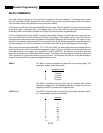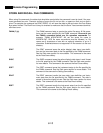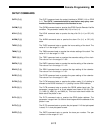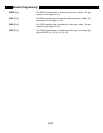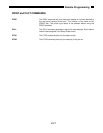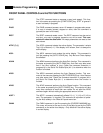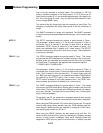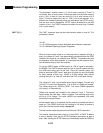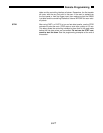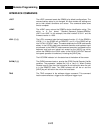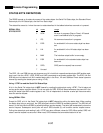
6-23
Remote Programming
DATA TRANSFER COMMANDS
OUTP ? i The OUTP? i command reads the value of X, Y, R or . The parameter
i selects X (i=1), Y (i=2), R (i=3) or θ (i=4). Values are returned as ASCII
floating point numbers with units of Volts or degrees. For example, the
response might be "-1.01026". This command is a query only command.
OUTR ? i The OUTR? i command reads the value of trace 1, 2, 3 or 4. The
parameter i selects the trace (i=1, 2, 3 or 4). Values are returned as
ASCII floating point numbers with units of the trace (as displayed on the
bar graph). For example, the response might be "-1.01026". This com-
mand is a query only command.
OAUX? i The OAUX? command reads the Aux Input values. The parameter i
selects an Aux Input (1, 2, 3 or 4) and is required. The Aux Input voltages
are returned as ASCII strings with units of Volts. The resolution is
1/3 mV. This command is a query only command.
SNAP ? i,j {,k,l,m,n} The SNAP? command records the values of either 2, 3, 4, 5 or 6 param-
eters at a single instant. For example, SNAP? is a way to query values of
X and Y (or R and θ) which are taken at the same time. This is important
when the time constant is very short. Using the OUTP? or OUTR? com-
mands will result in time delays, which may be greater than the time con-
stant, between reading X and Y (or R and θ).
The SNAP? command requires at least two parameters and at most six
parameters. The parameters i, j, k, l, m, n select the parameters below.
i,j,k,l,m,n parameter
1 X
2 Y
3 R
4 θ
5 Aux In 1
6 Aux In 2
7 Aux In 3
8 Aux In 4
9 Reference Frequency
10 Trace 1
11 Trace 2
12 Trace 3
13 Trace 4
The requested values are returned in a single string with the values sep-
arated by commas and in the order in which they were requested. For
example, the SNAP?1,2,9,5 will return the values of X, Y, Freq and
Aux In 1. These values will be returned in a single string such as
"0.951359,0.0253297,1000.00,1.234".
The first value is X, the second is Y, the third is f, and the fourth is
Aux In 1.
The values of X and Y are recorded at a single instant. The values of R




